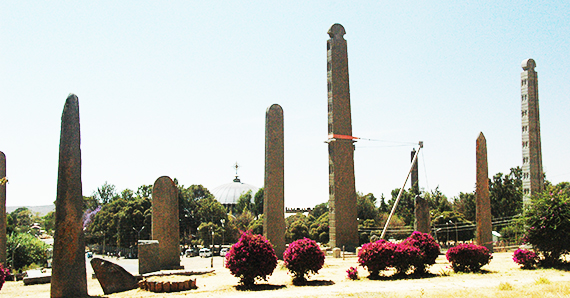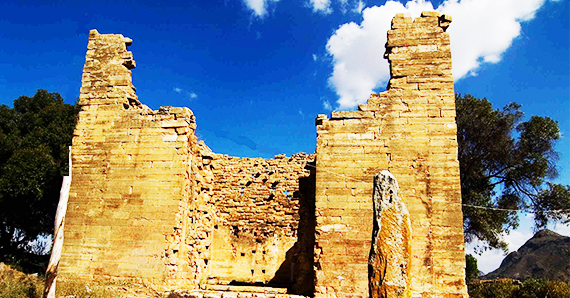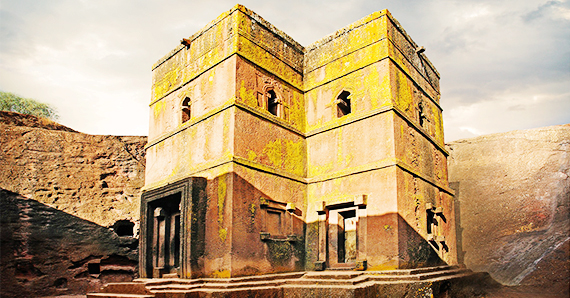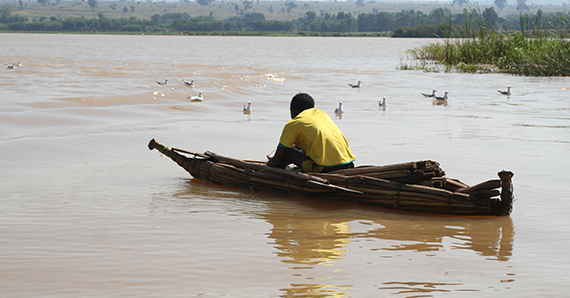




The legacy of the Queen of Sheba lies just below the shifting sands, and churches hewn out of sheer rock attract wide-eyed tourists. The African nation's historic route begins in the ancient city of Axum, which dates to about 100 B.C. This capital city was the first place in Ethiopia to adopt a new religion -- Christianity. According to the Old Testament, The Queen of Sheba was born in Axum, but travelled to Israel to meet King Solomon. They had a son named Menelik, who later became the first emperor of Ethiopia. Menelik brought the original Arc of the Covenant back to Ethiopia from Israel. Today, the Arc, which once housed the Ten Commandments, remains well hidden in Axum. It is guarded by a select group of monks, whose sole commitment is to protect the sacred vessel. Axum is also known for its massive, towering sculptures that are more than two thousand years old. Their significance is still under investigation by archaeologists.
365 kilometres northeast of Gondar lies the town of Axum, Ethiopia's oldest city. Axum dates back some 2,000 years to when it was the hub of the Axumite Empire. The Queen of Sheba made it her capital 1000 years before Christ. The Ethiopian Orthodox Church was founded here in the fourth century and Axum remains the holiest city of the Ethiopian Orthodox Church.

Yeha is situated in the northern mountainous section of the Tigray region. Although today this small settlement survives as a shanty town, it was once a site of great pre-Axumite civilization. Believed to be Ethiopia's first capital, Yeha was first uncovered in a complex archeological excavation around a courtyard at the beginning of the 20th C. The first settlers of this area, the Sabeans, were the founders of the Axumite kingdom.
The temple of Yeha, with one side of its walls in ruin, is otherwise still intact and testifies to the advanced level of the people of those times. There is no trace of mortar being used to build the temple of which the inside of the walls was believed to be have been paved with gold.
The archeological excavations made in 1909, 1947 and 1973 respectively, reveal that this beautiful temple was destroyed by fire. Treasures such as gold rings, golden lions, stone-engraved inscriptions written in Sabean, stone-carved animals like the Walya ibex (one of Ethiopia's endemic mammals), pottery works and others were uncovered. Some of these findings are displayed in the 4th-century church museum found in the same compound as the temple while others are displayed at the National Museum in Addis Ababa. The twelve underground formations and four other very deep cave structures (which seem to lead to Yemen, Lalibela, Jerusalem and Axum), increase the area's importance in terms of both archeological research and tourism.

Ever since the first European to describe the rock churches of Lalibela, Francisco Alvarez, came to this holy city between 1521 and 1525, travellers have tried to put into words their experiences. Praising it as a “New Jerusalem”, a “New Golgotha”, the “Christian Citadel in the Mountains of Wondrous Ethiopia”. The inhabitants of the monastic township of Roha-Lalibela in Lasta, province of Wollo, dwelling in two storeyed circular huts with dry stonewalls, are unable to believe that the rock churches are entirely made by man. They ascribe their creation to one of the last kings of the Zagwe dynasty, Lalibela, who reigned about 1200 A.D.
The Zagwe dynasty had come to power in the eleventh century, one hundred years after Queen Judith, a ferocious woman warrior had led her tribes up from the Semyen mountains to destroy Axum, the capital of the ancient Ethiopian empire in the north.

The town of Bahir Dar is located 180km south of Gondar on the shores of Lake Tana in the north of Ethiopia. It came into prominence in the 18th C. as a commercial destination for trade caravans to and from Gondar and the surrounding area. Today, it is one of the most attractive towns in Ethiopia and serves as a celebrated tourist destination. It hosts the fabled Blue Nile falls, the beautiful highland Lake Tana and 14th-century island monastic churches.